Mark Sisson's Blog, page 380
June 16, 2012
Tender Grilled Baby Octopus
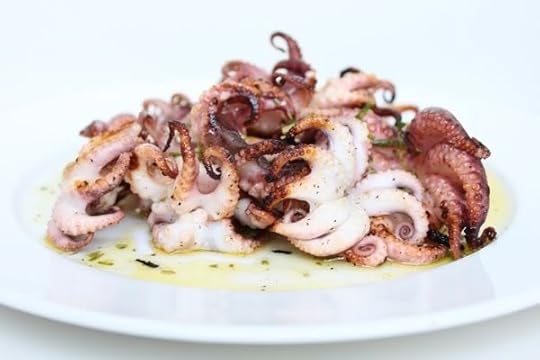 There are few animals as visually stunning as a baby octopus when cooked. Purple-tinged arms curl and twist into an eye-catching swirl that looks more like a sculpture in an art museum than a meal on a plate. When it comes to food, however, beauty only goes so far. Eventually you’ve got to stick a fork in it and satisfy your hunger.
There are few animals as visually stunning as a baby octopus when cooked. Purple-tinged arms curl and twist into an eye-catching swirl that looks more like a sculpture in an art museum than a meal on a plate. When it comes to food, however, beauty only goes so far. Eventually you’ve got to stick a fork in it and satisfy your hunger.
Either as an appetizer or main course, this recipe for grilled baby octopus is a stunning meal that will please both the eyes and the palate. An easy three-step cooking method (blanching, marinating, then grilling) creates tender, crispy octopus drenched in a garlicky, herby marinade and dressing.
Plain octopus has a delicate flavor that’s slightly sweet and similar to that of a scallop. In fact, the flavor of octopus can be so mild that it’s hard to dislike but octopus can present a textural challenge. If your last experience with octopus was a little like chewing on a tire, this recipe will win you back. Dropping the octopus in boiling hot water for just a minute cooks it halfway and helps tenderize the meat. A long soak in a marinade continues the tenderizing process and also gives the meat most of its flavor. Finally, a quick sear on the grill intensifies the flavor and gives the edges a charred, crispy texture.
Baby octopus is usually sold frozen at seafood stores although occasionally you’ll find it fresh. If the heads are still on, they need to be cleaned out (see below) or you can just cut the heads off and get rid of them. This is a personal choice: Once cleaned, the head is edible although not always as flavorful as the rest of the body.
Baby octopus…so simple to make, so beautiful to look at and so delicious to eat!
Servings: 2 as a main course, 4 as an appetizer
Ingredients:
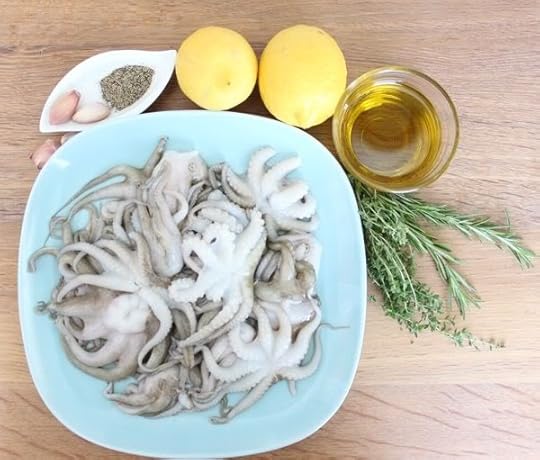
2 pounds baby octopus
1/2 cup olive oil
Juice of 1 large lemon
3 garlic cloves, finely chopped
10 sprigs of fresh thyme
1/2 teaspoon salt
1 teaspoon black pepper
Dressing:
1 teaspoon chopped fresh rosemary
1 tablespoon plus 1 teaspoon lemon juice
3 tablespoons olive oil
1/2 teaspoon lemon zest
Instructions:
If the octopus is frozen, defrost completely.
If the octopi still have their heads, you can either cut the heads off and discard them or keep the head on. If you choose to keep the head on, however, make sure it’s cleaned out. If it’s not, then you can approach the task two ways:
Make a shallow cut along the head, being careful not to cut too deep and puncture the innards. Carefully but firmly pull out everything inside.
Cut the head off, turn it inside out and use a knife to scrape away the innards.
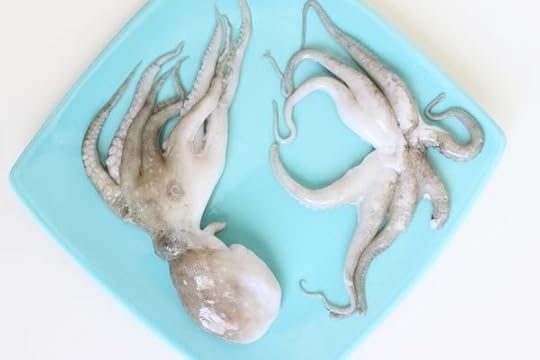
In both cases, if a small black, triangular beak does not come out along with everything else, then push your finger up through the middle of the body and the beak should pop out. Rinse the octopi and set aside.
To make the marinade, whisk together the 1/2 cup of olive oil, plus lemon juice, garlic, thyme, salt and black pepper. Set aside.
In a large pot over high heat, bring 5 cups of water to a boil. Turn the heat off and dump the octopuses into the pot.

Let sit for 1 minute then drain immediately. Rinse with cold water.
Combine the octopus and the marinade, either in a large bowl or sealed plastic bag. Refrigerate for at least 2 hours, but ideally 4.
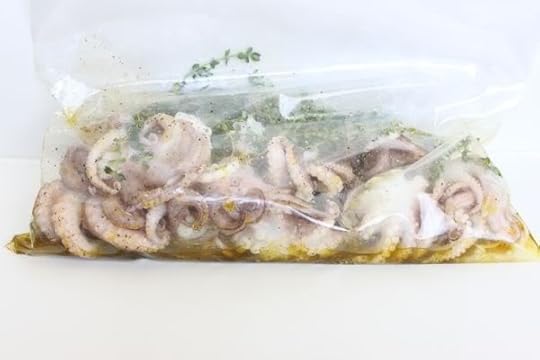
Soak 4 wooden skewers in water. Heat the grill to high.
While the grill is heating, make the dressing by whisking together the rosemary, lemon juice, lemon zest and remaining olive oil.

Skewer each octopus, putting 3 to 5 on each skewer (if you have heads that are separate from the body, skewer them too). Grill over high heat, letting the flames char the outside, but turn the skewers a few times so the octopus doesn’t burn. A total of around 6 minutes on the grill is usually about right.

Remove from the grill; drizzle with rosemary dressing. The octopus can remain whole, or you can slice it thinly. Grilled baby octopus can be served hot off the grill, or you can chill it and serve cold with extra lemon wedges on the side.

Grab a copy of Primal Blueprint Quick & Easy Meals for over 100 Primal Recipes You Can Prepare in 30 Minutes or Less

June 15, 2012
I Now Have Respect and Love for My Own Body
It’s Friday, everyone! And that means another Primal Blueprint Real Life Story from a Mark’s Daily Apple reader. If you have your own success story and would like to share it with me and the Mark’s Daily Apple community please contact me here. I’ll continue to publish these each Friday as long as they keep coming in. Thank you for reading!
 I know I sound crazy. Like, Hare Krishna, ran off and joined a cult, crazy. But this is all true, and I know it is, only because I experienced it firsthand. Am I a good example, or a horrible warning? Hopefully, if I play my cards right, I can be both.
I know I sound crazy. Like, Hare Krishna, ran off and joined a cult, crazy. But this is all true, and I know it is, only because I experienced it firsthand. Am I a good example, or a horrible warning? Hopefully, if I play my cards right, I can be both.
My memories of childhood are hazy. Especially names, places, and dates. I spent a lot of time, just sort of “drifting” with the current. I remember images, and faces. And I remember being sick a lot. Not like “I HAVE THE SCARLET FEVER!” sick, but just a runny nose, and teary eyes. Since I grew up in California’s Central Valley, no biggie: seasonal allergies were legendary there. Hay fever was just assumed. The fact that it turned into sinus infections on a regular basis was just a given- right? As I got older, it would last year-round. Inevitably at the first cold snap, I would lose my voice. There was always a chalky pink bottle of amoxicillin in our fridge door, right below the milk.
I was also prone to ear infections, and vividly remember a procedure at around age 5 where they made me swallow “something that glowed” and then not being allowed to move so they could get a better idea about the bladder infections I couldn’t seem to kick.
I seemed to outgrow most of it: with the exception of the lethargy and the sinus stuff. Poor Mom knew something “wasn’t right” and dragged me to so many doctors: to have my thyroid tested, to check for allergies, and everything came up “fine”. The ENT guy finally just said, “This kid is sniffling constantly because she has teeny nasal passages, and gigantic adenoids. She might grow out of it, or she’ll need surgery as an adult.“ Great. By default, I became a chronic mouth-breather.
School was OK. I was quiet, usually characterized as a “dreamer” and by teachers who paid attention, an “underachiever.” Since I wasn’t a behavior problem, what would now probably be diagnosed as “ADD” was never noticed. I tested well, but in a noisy classroom, I had the attention span of a gnat, unless I could focus on one thing at a time. Two things I was great at: reading books or watching TV. If I was on my own playing with a friend, I was fine, but slumber parties were a disaster: all my high-pitched peers in a room together talking at once were absolutely overwhelming. I viewed these rites of passage with dread, as I knew I didn’t fit in, and my involuntary snoring was something humiliating I would be teased about later on. And I was always tired, so I’d be the first to fall asleep.
The first recollection I had of sneaking food would have been around the age of 10. Maybe it’s just that I was embarrassed to be caught at that age: I think it probably started earlier, but was written off as just being a kid. I was always hungry, and was getting “chubby”. My parents didn’t say anything about it: just implemented family walks after dinner, or I would ride my bike while Dad jogged. It just seemed to make me hungrier.
My first official diet was in the summer between 6th and 7th grade. I begged Mom to send me to Weight Watchers. Kids had been teasing me at school. I wasn’t 12 yet, so I needed a note from my doctor. I remember the scornful faces of the other kids in my group when they heard I only had 10 lbs to lose. They wanted to know just WHY was I there? They had been forced to attend these humiliating meetings, by their parents, by medical professionals. Back in the mid 80’s, there was usually only one kid at school who resembled Augustus Gloop, which was the limit of my experience until then. There they were, all gathered at Weight Watchers in an obese and resentful horde. They had 40, 50, 60 lbs to lose. To this day, I hope I wasn’t smug. I do remember thinking, in my 11-year-old ignorance, “If I ever get that heavy, I would just want to die.”
So Mom encouraged me to fill in my nutritional log. She joined with me for moral support. We went to the store together to shop for special diet food, and I learned to count – this was before points, I think they were called “exchanges” back then. I got more exchanges because as a kid, I was still growing. I checked off my boxes, and rejoiced because I could have peanut butter on my rice cakes for breakfast every morning. Which may be the most depressing food-related sentence ever written.
I lost 8 lbs that summer, writing everything down, checking off boxes, exercising faithfully. Between that and my graduation from thick glasses to contact lenses, I was evidently unrecognizable. When I went back to school, I was like Clark Kent, except my phone booth was a diet center, and instead of spandex and a cape, I had ankle-zip acid washed Guess? Jeans, Reebok hightops, and an Esprit book bag. Mom was excited not to have to shop in the “Big Girl” section, and we had gone all-out.
At my 12th birthday in November, I got a clown sundae from Farrell’s, and devoured it under the disapproving eyes of my father, who said, “You’re not going to eat that, are you?“ And of course, by the time Christmas rolled around, I ate a pizza pocket or three from the snack bar, and had gained all that weight back plus more. Mom was still packing a nutritious lunch: carrot sticks, celery, a sandwich on white diet bread with turkey breast and a slice of low-cal plastic cheese (mustard only!) along with a little bag of pretzels (lowfat!), sometimes a non-fat yogurt sweetened with aspartame and flavored with God-knows what, and a diet cream soda. I would say 50% of the time, into the trash it went. My peers could eat pizza pockets with no problem, and I desperately wanted to be like them. But metabolically, I just wasn’t. At 12, this was difficult to understand.
This is around the time I started having problems with cystic acne. I didn’t know what it was, just told dad that my ear was hurting me. I do remember the look on his face when he peered inside my ear and recoiled. The next thing I knew, there were needles and matches and alcohol and pressure and pain and blood and yelling. OH the yelling! Mostly from me.
After a few more incidents like this, my long-suffering mother took me back to the pediatrician. He peered into my ears with his trusty otoscope, and said, in his German accent: “I don’t like this. Usually, this is an indicator of outbreaks as a teen and young adult.” I sat sullenly through this, and as a gesture of pre-teen hostility, refused to let him draw his trademark duck on my arm with a ballpoint pen.
So I religiously swabbed my ears with alcohol, and tried to avoid chocolate. The acne continued, and worsened, and spread. And inevitably, every summer, and sometimes in-between, I was on a diet. Slim-Fast, Weight Watchers (multiple times), Low-fat on my own, you name it. Some of them worked for awhile, but I would inevitably take a break and get discouraged, and BOOM: twice as much to lose next time around. I remember lying in my bed, listening to my stomach rumble, and looking at the tiny pink hearts on my wallpaper in my bedroom, and just wishing. My weight became something I prayed about, a constant reminder that Something Was Wrong With Me.
As I got closer to college, and gained and lost, and gained it all back plus more, I got more discouraged. I needed to lose 40 lbs, then 50 – my parents got more concerned. Bribery: promises of money, of new clothes, of the choice to attend the private university I had fallen in love with on my visit there – they were all dangled before me. And oh, by God, I tried. When conventional methods failed, I tried to make myself throw up – and am now thankful for the fact that it didn’t work.
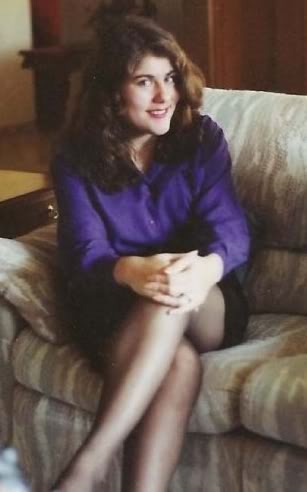
I was so embarrassed by my seeming lack of control over my body, of my appetite that strove to thwart me, of the fact that I constantly felt like I was starving, of my figure, which was an exaggerated hourglass that was impossible to shop for in the junior section. It was also impossible to walk to the bathroom in a TGI Friday’s without some dudebro at the bar trying to pick me up. Dad would walk me to the bathroom when we went out to eat. I was 16, and I looked like a 30 year old cocktail waitress.
This is also when the long-awaited facial breakouts started to happen. I ping-ponged back and forth from the allergist, to the endocrinologist, to the ear, nose, and throat doctor. I didn’t get any answers, but actually did lose some weight, due to the mass quantities of antibiotics I was taking, both orally and topically (I constantly had stomach acid). And then on my last checkup before college, I went to see the same gynecologist my mother went to: an old-school gentleman, who ordered my mother out of the room, asked if I was sexually active (NOPE) and gruffly handed me a prescription for birth control pills, with the instructions, “You’re a lovely girl: don’t ruin your life.” Then he added, as an afterthought, “These might help with your acne, too.”
I coasted through college. I was still drifting through life like a jellyfish, but now I was away from my family and still not technically an adult, so I had zero guidance or parameters. Luckily, I made some great friends, and learned how to fake it. I grew up: I got a little edgy. I threw parties, and went to more parties, and then everything just came to a screeching halt.
I just sort of abandoned any kind of responsibility in my life. To this day, I couldn’t tell you what happened. There wasn’t any sense of choice about it: I evidently had coasted for so long, I just traveled straight into a brick wall. I am guessing what I was dealing with was depression, although I didn’t know that at the time, and couldn’t explain it when my parents wanted answers – WHY?!! I couldn’t get enough sleep, and I stopped returning calls. I checked out.
Back to the endocrinologist. Back to a doctor, who was a friend of the family, who had been briefed beforehand. Also, a psychiatrist. My parents were frantic for any explanation. Alien abduction? Hormonal imbalance? I had only ever been marginally present in my own life anyway, and I look back at this entire time through a haze. There is no real answer. I couldn’t tell you if I blocked it out in the interest of self-preservation, but that is a guess. I was in a dark place, just drifting. I just remember the reaction of the endocrinologist the most, when he reassured me that I was normal and there was nothing wrong with me, and I burst into tears. He patted me on the shoulder sympathetically, and said, “I do not think the problem is you. I think the problem is something else.”
I moved back in with my parents briefly, realized immediately that it wouldn’t work, and moved out again as soon as I got a job. A super-cheap two bedroom apartment with a roommate was my salvation. I was half-heartedly attending a local college because I didn’t know what else to do, and somehow ended up playing swing music on the college radio station at 1 AM. This dovetailed nicely with my job doing graphics and filming the news at a TV station. I also started to “wake up” – with a vengeance. I had gone into my coma at 180 lbs, and come out of it at…I would estimate, 260. I don’t know for sure, because I refused to get on a scale. I lost some of it on my own, but the solution for the rest was to go to a “medical weight center” and they hooked me up with a pill called Bontril. They weighed me weekly and took my blood monthly, and for the first time in my life, I could wake up for work on time and lose weight, spend an hour on the elliptical at the gym every day, and clean my grout at 4 AM with a toothbrush. In the plainest sense, it was probably a lot like crack. However, my thoughts had a crazy sharpness. For the first time in my life, I had some clarity. I remember wondering, “If everyone functions at this level all the time, why can’t I?”
I met the man who would become my husband when he called into the radio station late one night. A lot of guys would call: they evidently found my 2 AM rants about Cheez-Its and my husky and congested voice strangely alluring – but he was the only one who had asked me about the music I was playing, not what I was wearing. I remember being shocked when I met him – what I thought would be just a funny story for my friends later, ended up being someone who I hit it off with immediately. We will celebrate our 10 year anniversary at the end of July, 2012.
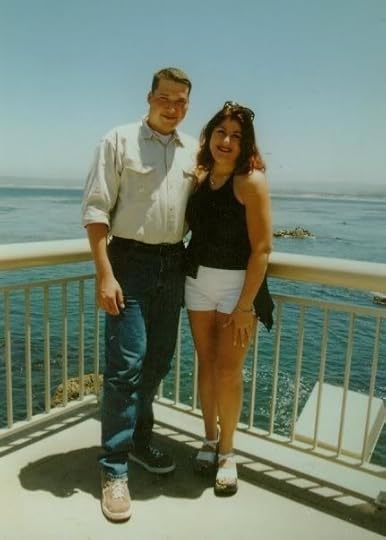
By the time we had gotten engaged, I had gotten down to 200 lbs, which for me is about a size 12. I’d done it thanks to the looming threat of the impending wedding, my willingness to exercise like a crazed hamster on a wheel, the fact that I had no appetite thanks to chasing the Bontril Dragon, and the fact that surviving pretty much solely on reduced-fat Smart Pop microwave popcorn didn’t kill me first.
I got married. I think I gained back 20 lbs over the course of my Bontril-free honeymoon. My husband was deployed for six months, and when he got back, we started trying to start a family. And trying. And trying. Once again, after a full workup, the doctor said there was nothing technically wrong with either of us, but suggested weight loss would help with my fertility. I tried Bontril again, but it didn’t work. I tried anything and everything I could think of. We went through horrible fertility treatments. At the end, we were emotionally and financially drained. I was back in depression central, and all I could do was eat cookies and cry. I never had much direction in life, except wanting to be a mother, and this seemed like the ultimate betrayal of my body. It could not even do this, something that every woman should inherently have the capacity to do, and what I had always wanted.
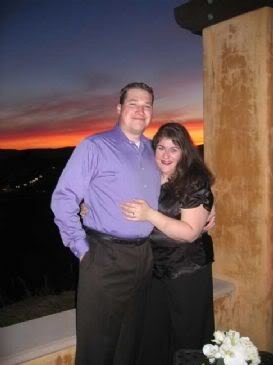
Surely, this should be the motivation I needed. Motherhood was my brass ring. But the weight, which once would disappear (albeit, briefly) if I followed the rules, had begun to defy the guidelines I had so carefully drilled into myself. I would get down to a certain weight, 215, and exercise faithfully, lift weights, count every calorie – and gain. I bought a pedometer, I bought a polar heart-rate monitor, I bought a Go-Wear Fit, I tried eating more whole grains, I went to the doctor, I did the math, all to no avail. The doctor I went to actually said I wasn’t being honest with myself, and tried to explain how to do circuit training to me. Me, veteran of many gym memberships, personal trainers, and hour-long sessions on the elliptical! Pfft! But what was worse, I was getting debilitating migraines once or twice a week, crazy PMS, my acne had branched out into rosacea, and my hair started falling out! I blamed stress.
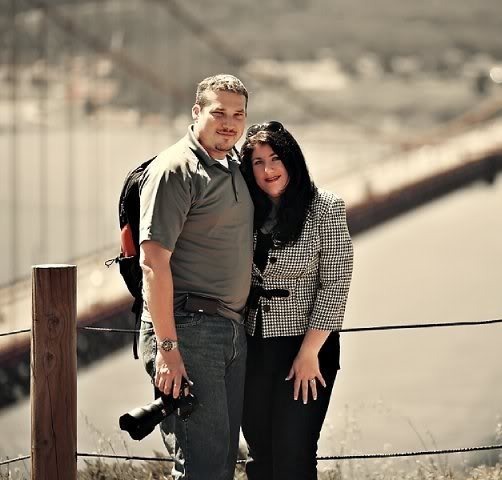
The hard-learned truth: when you eff with Mother Nature, Mother Nature effs right back with you. 25 years of yo-yo dieting and chronic cardio, not to mention a constant barrage of pharmaceutical crap in the name of health, had trained my body to hang on to whatever it could for the upcoming famine ahead. I know that now.
I was at rock bottom, and had been flailing for awhile, when I found The Primal Blueprint.
There’s a sentence in the book that details the many things gluten sensitivity can cause: Brain fog. Infertility. Migraines. Congestion. Acne. Lethargy. Depression. Those are the things I can remember. Because when I read them, I screamed, and threw the book against the wall. It was like opening a dictionary, and seeing my face. All I could think of was all the stress, the doctor visits, self-flagellating behavior, the pills I had taken and shots I had given myself and money that had been spent. Could it really boil down to this? The recurrent infections and depression and congestion and ditziness since childhood? This whole acne/infertility weight loss nightmare? Was it true that a change this simple could have seriously changed my entire life?
I just thought, well, I just thought it was me. But that long ago Indian endocrinologist, maybe he was right. It wasn’t me, it was something else. Maybe grains and sugar were that elusive “something else”?! I looked at myself, a thirty-five year old woman, who loves her technology, her smartphone, her curling iron, high heels, jewelry, and cosmetics. Underneath that sophisticated (albeit, obese) veneer, could I really be a cavewoman?
It was time to find out. I chucked grains. All of them. I cut drastically back on sugar.
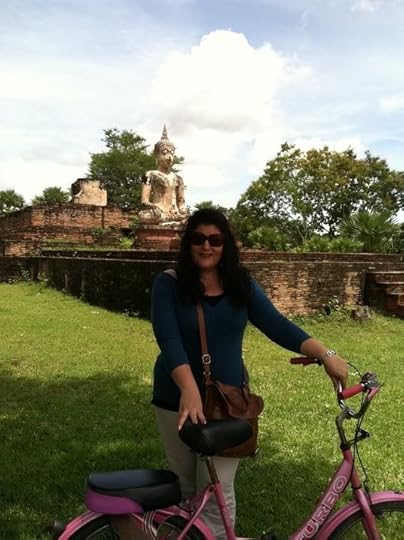
Within three days, my rosacea was noticeably diminished. Within a week, my snoring was quieter, and I was waking up refreshed for the first time in years.
In two weeks, my skin was clear. I get the occasional zit, and the scars still remain, but this in itself is a minor miracle. Also, I had lost 5 lbs. And I was not constantly hungry. My eyes, which were always, always bloodshot, like I had been hotboxing in someone’s VW van, suddenly revealed that they had white sclera!
A month in, I was 10 lbs down, and I had my waist back. News flash -you typically look better and it’s a lot easier to wear clothes when you are no longer shaped like a potato. This is also when I realized that my debilitating migraines were blood-sugar related, because they stopped happening. I also was waking up in the morning before my alarm. I had amazing amounts of energy.
Two months in, I could breathe through my nose. This is still something I have to focus on, as I have been conditioned by decades of having to breathe through my mouth. Those teeny tiny nasal passages and giant adenoids? I am guessing that was chronic inflammation, even as a kid.
That winter, My “hair guru” reported that my hair was thickening back up, and no longer falling out. And my seasonal depression just didn’t happen. My husband called me a pet name, his “little black raincloud” – or at least he started to, and then he said “You know, that really doesn’t suit you anymore.” “My little piranha” also seems to have disappeared from the repertoire without comment. Thank God.
Another traditional winter hallmark: my horrible recurrent sinus infections: didn’t make any appearance. And let me tell you, I sure as hell don’t miss them. I haven’t had one since. I have a familial history of high cholesterol: While I did get a big scary number recently, my ratios are good and my triglycerides, after decades of being elevated, are nice and low.
After 6 months, I went home for Christmas, and saw a friend of the family, who asked, ”What are you doing? You look so…healthy. And happy!” And without thinking, I smiled and said, without thinking, “Thank you! I AM happy!” And it’s true. I am. Nobody is more surprised about that fact than I am. When I run into people I haven’t seen in awhile, they will inevitably ask, “What are you doing?!” And I am happy to tell them.
I almost didn’t write this because, well, I didn’t magically get skinny. There’s no “big reveal” with me wearing a crop top to show off my 6-pack abs. I do still have bad days, when I have to remind myself that skinny and healthy are not the same thing. I do occasionally get the “stink eye” from some poor deluded schmoe when I throw uncured bacon into my shopping cart. While I haven’t lost a lot of weight, I am able to eat like a normal human being and maintain. I am repairing decades of damage that I did to myself, and it’s just going to take time – and patience.
By that token, I have been spared adding another 30-50 lbs to my grand total for the 2.5 years I have been eating this way. Which is no mean feat! And I am getting stronger, and exercising more because I enjoy it now, not because it’s a chore. Life is short. I do what I love: Zumba classes, walking, riding my bike and playing active games on the Wii. And occasionally go on new adventures. The last one was going opal mining in the Nevada desert over Memorial Day weekend. My (new, awesome) doc says she will clear CrossFit when I get a little lighter. I know, you can scale, but as she says, you only get one pair of knees. Can’t argue with that.
There are so many gifts I have gotten from following the PB. My health, my motivation, my identity, the ability to buck the system and go with my gut, self-worth, and respect and love for my own body and what it can do. Hopefully, motherhood is next. All of those things are beyond price. Thanks a million, Mark, for what you do!!!
Grab a Copy of The Primal Blueprint 21-Day Total Body Transformation and Start Getting Primal Today!

June 14, 2012
How to Fuel Ultra-Distances: The World’s Toughest Mudder
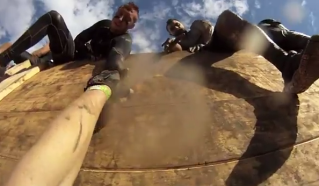 A couple weeks ago, I received an enthusiastic email from a group of Aussies. They were planning on competing in the World’s Toughest Mudder (WTM), a perversely-warped, extreme version of the regular Tough Mudder that has contestants complete as many 8-10 mile circuits as they can in a single 24-hour period. To get the spot in the WTM, their four-man team had to place in the top 5% of finishers in the Melbourne Tough Mudder, so they aren’t physical slouches by any means. They’re also Crossfitters, rugby players, and avid Primal eaters. Simply put, these guys make us real proud.
A couple weeks ago, I received an enthusiastic email from a group of Aussies. They were planning on competing in the World’s Toughest Mudder (WTM), a perversely-warped, extreme version of the regular Tough Mudder that has contestants complete as many 8-10 mile circuits as they can in a single 24-hour period. To get the spot in the WTM, their four-man team had to place in the top 5% of finishers in the Melbourne Tough Mudder, so they aren’t physical slouches by any means. They’re also Crossfitters, rugby players, and avid Primal eaters. Simply put, these guys make us real proud.
They weren’t writing just to say “hi,” however. They also needed Primal fueling advice, especially since the guy who won last year’s WTM ate anything but Primally. For a single, one-time, all-out event, I’d actually say that making concessions with your diet are fine, but these guys weren’t having it. They wanted to stay Primal for the duration and avoid all the sugary gels and extruded pasta in a vacuum bag (yes, people are really eating this).

Did I already say they make us proud?
Well, is such a thing even possible? And if so, how would you go about doing it?
Let’s read the relevant portion of their email before we begin:
Hi Mark,
On the 31st of March 2012, myself and a team of mates competed in Australasia’s first ever Tough Mudder race on Phillip Island in Melbourne, Australia. Tough Mudder is a 20km obstacle course race designed by British Special Forces which tests endurance, strength, mental commitment and teamwork and is one of around 30 events held annually across the globe.
Out of the 26,000 entrants in the Melbourne event, my team and I managed to finish in the top 5% of all finishers and subsequently have been selected to go to the world championships in Englishtown, New Jersey, USA. The world championships puts the world’s most hardcore Mudders through a grueling 24-hour challenge designed to find the toughest team on the planet. When the mud settles on November 18th, 2012, a select few winners will have bested 500,000 others worldwide for the right to call themselves the World’s Toughest Mudders.
Like any good team about to undergo a huge challenge we have been researching the event and preparing mentally and physically. As Primal eaters we are obviously interested in diet. Last week we found the winning athletes’ diet (Junyong Pak) from 2011 below is his advice and Race Diet plan (I think this much sugar could kill all 4 of us!)
‘In addition to Powerbar gels, I decided to supplement with canned fruit in heavy syrup, pasta, PB&J, protein drink, gatorade, honey, eggs, and bananas. I forgot to eat the honey, and did not make eggs or bring bananas but ate everything else. The canned fruit (peach chunks, halved pears) was a huge winner. I packaged these into vacuum seal bags such that each bag contained half a can of fruit, or 175 calories. These were robust bags that did not break, relatively compact, and also supplied some of my water intake. I could bite off a corner of the bag without taking my gloves off and bite the fruit out like a gel. I packaged the pasta in similar fashion with much success.’
Mark, as you can see, I think if we did this we would all be in a sugar coma and never wake up. Can you help us come up with something Primal to fuel us through the race?
4 Man Team:
James Laird: 28 yrs, 6’2″, 95kg
Scott Laird: 25 yrs, 6’1″, 80kg
James Stiles: 28 yrs, 6’2″, 88kg
Marc Burbrough: 25 yrs, 6’4″, 92kg
Thank you and regards,
PRIMAL TOUGH MUDDERS
Here’s a video of the guys in action to give you an idea of what they’re up against:
It’s gonna be like that, only crazier, and performed multiple times across the day.
First of all, hats off to them. If I had to do another ultra endurance event sometime in my life, the World’s Toughest Mudder would probably be high on my list. It looks like good, clean (well, dirty, actually) fun. It may be fun that takes a week to recover from, but fun nonetheless.
Second, the WTM is not just an ultra-endurance event. With some 24 obstacles ranging from sprints up steep muddy hills to climbing towers and vaulting over walls to swimming through ice-water (and plenty of as-yet unannounced obstacles), you’re not just going to chill out in the oxidative energy pathway, burning fat for energy. The bulk of your energy can – and will, if you take the necessary steps – come from fat, but defeating most of those obstacles (over and over again across 24 hours) will also require intermittent forays into the ATP-PC and anaerobic pathway. Your nutrition, then, has to take both aspects of the race into account.
A month or two before the race:
Become a fat-burning beast.
This may not be a stretch for you bunch, seeing as how you’re already following a Primal eating plan. If you are fat-adapted, stay adapted. If you aren’t, get fat-adapted. Being a fat-burning beast will help you efficiently burn all that body fat for energy (and even the lean among us have enough body fat to provide energy for a 24 hour ultra distance event) and hold off on burning glycogen until you really need it. Doubleplusgood. If you aren’t already adapted, I would recommend limiting your daily carb intake to around 60-70 grams in the months leading up to the race. This will train your body to rely on fat for energy while sparing glucose.
Titrate down your Crossfit metcons.
I know, I know – if you’re like most CrossFitters, you get off on the metcon intensity, and you owe a lot of your physical prowess to training that way. But those metcons burn through glycogen like crazy, and if you continue to follow the 3 on, 1 off (or even 2 on, 1 off) workout schedule without upping the carbs, you’re going to burn yourselves out. Keep the metcons to once, maybe twice a week, shorten them up considerably (5-10 minutes instead of 20-30 minutes), and up the intensity while reducing the volume. Make sure to do some simple, basic, low-rep, low-volume, high-intensity, low-stress strength work instead.
A couple days before the race:
Fill those glycogen stores.
But Mark… didn’t you just say to go low-carb to maximize our bodies’ fat-burning and glucose-sparing potential? What gives? Simple. Two days of (healthy Primally sourced) carb loading to the tune of 350 grams or so per day will top off your glycogen stores. Since you’ll be getting your carbs from whole food sources like sweet potatoes, potatoes, squash, fruit of all kinds, and, if you swing that way, rice, you may have to eat what seems like a large amount of food. It’s not, not really. People act like it’s impossible to eat carbs while eating Primal, and I don’t get it. Just reach for the tubers and fruit.
Take it easy.
Don’t CrossFit, don’t lift, don’t do much of anything that will sap your stored energy and exhaust your muscles. Go for a walk, work on mobility, do some yoga, or do nothing at all. Enjoy your (brief) time off!
Race day:
Eat a light breakfast.
Couple strips of bacon, a couple eggs, some fruit, and strong coffee. This will give you a bit of something in your stomach without weighing you down, and the coffee will liberate some fatty acids for use during the event (not that you need help with that).
Eat some medium chain triglycerides (MCTs).
Why MCTs? They can’t be stored, meaning they must be utilized for energy. MCTs also increase the production of ketones. These are good things, since fat is going to be your ticket through this race. In most cases, I’d tell you to get your MCTs from a whole food source, like coconut oil. Not today. Today, I want you to take three tablespoons of pure, unadulterated MCT oil. If the thought of that appalls you, try frothing it up in your coffee.
Drink some salty broth.
Broth, especially homemade broth dosed with plenty of sea salt, provides easily-assimilable electrolytes like sodium, calcium, and magnesium. You’re going to be excreting a lot of sodium, so add 2-4 grams of sodium. Not salt, but sodium. Hey, didn’t I say to drink salty broth? For reference, sea salt is about 1.8 grams sodium per teaspoon, while table salt is about 2.3 grams sodium per teaspoon.
During the race:
Keep a fat source at hand.
MCT oil, nut butter, and coconut oil are squeezable and fat-rich. Maybe toss in some hard-boiled eggs for protein and fat.
Keep a slow-digesting carb source at hand.
Peter Attia, the endurance athlete who’s been training in a ketotic state for months now, recommends Superstarch, a non-GMO cornstarch that provides steady, even glucose. Best of all, Superstarch doesn’t spike insulin, especially when compared to maltodextrin, so you can take it during a race without impacting your ability to burn fat.
If you can’t get your hands on Superstarch, plain cornstarch (not maltodextrin, which is absorbed too quickly and results in too large an insulin spike) will work tolerably well.
Keep an energy drink on hand.
I recommend the molasses/honey/coconut water hybrid mentioned in this post. Consider mixing in more sea salt for sodium, too, as you’ll be excreting tons of that.
That’s what I’ve got. The key to doing this thing in a low-carb state, of course, is that you are completely fat-adapted. Becoming a fat-adapted fat-burning beast will make you or break you. Choose wisely, my friends, and be sure to let us know how you do! Grok on!
Get the Free 7-Day Course on the Primal Blueprint Fundamentals for Lifelong Health Delivered to Your Inbox

June 13, 2012
How to Work Outside (Even If You’re a Desk Jockey)
 Last week, I told you why working outside – at least from time to time – can be helpful, relaxing, and even performance-enhancing. A number of you emailed me directly, or left comments thanking me for the idea. Most people were on board with working outdoors, but mostly in theory, because let’s face it – being outside on a workday with the sun shining and the birds chirping and the breeze blowing sounds fantastic, but how realistic is it, really? Even if you’re able to convince your boss to let you take the work outside, or you find a job that gives you the freedom to work where you like, the logistics of seamlessly moving a traditionally-indoor activity to the outdoors just seem insurmountable. How are you gonna get Internet access? How will you read your emails through the glare of the sun?
Last week, I told you why working outside – at least from time to time – can be helpful, relaxing, and even performance-enhancing. A number of you emailed me directly, or left comments thanking me for the idea. Most people were on board with working outdoors, but mostly in theory, because let’s face it – being outside on a workday with the sun shining and the birds chirping and the breeze blowing sounds fantastic, but how realistic is it, really? Even if you’re able to convince your boss to let you take the work outside, or you find a job that gives you the freedom to work where you like, the logistics of seamlessly moving a traditionally-indoor activity to the outdoors just seem insurmountable. How are you gonna get Internet access? How will you read your emails through the glare of the sun?
Before I launch into the logistics of working outdoors, I wanted to emphasize a few of the benefits. In Biophilic Design, author Stephen Kellert notes that psychologists have aggregated the five basic requirements for office workers that, if neglected or missing, can trigger worker dissatisfaction and comprehension problems (PDF):
Need for change (in temperature, air, scenery)
Ability to interact with the physical environment (beyond drink from the water fountain, use the toilet, and open doors)
Meaningful stimuli, lack of stagnant, unchanging environment (like a cubicle)
One’s “own territory to provide safety, an identity, and protection”
View of or access to the outside
At least 1, 2, 3, and 5 can be easily satisfied with more nature exposure. The outside world is always changing, the temperature is anything but constant, and you encounter extensive sensory stimuli. You can certainly interact with nature, by picking flowers, touching the grass, and that sort of thing, and being outside definitely gives us a nice view of the outside (since we’re in it). I don’t think it’s that nature is unique for giving us this stuff. It’s not that novelty is “good” for us. It’s that sameness is weird, alien, foreign. We may think we’re used to it, having lived with it for so long, but something ancient lurking deep inside us cries out in frustration and confusion when faced with an unchanging, non-stimulating, staid environment like an office. Or is it just me?
We need real nature, too. Technological nature such as plasma screens with images of rainforests and snow-capped mountains, orangutan screensavers (which I love – don’t get me wrong!), and nature soundtracks just aren’t the same. I think we know this instinctually, don’t we? They’re better than nothing, but they can’t really compare with the real thing. Unsurprisingly, the research suggests as much (PDF). In one recent 2008 study, people had access to either windows covered with curtains or high-definition plasma TVs (made to look like windows) depicting realistic nature scenes. Folks who saw the technological nature had improved psychological well-being, cognitive functioning, and “connection to the natural world,” while folks who saw the covered windows did not. Later, the same research group conducted another, similar study in which people either saw a real window revealing a real nature scene, a plasma depicting that same scene, or a blank wall. People who looked out the real window showed a better stress response, as indicated by a faster resumption of normal heart rate after exposure to mild stress.
With that out of the way, let’s move on, shall we?
Obviously, the people for whom this working outside stuff would be easiest to implement are the laptop jockeys, the mobile workers, and the writers. But one thing stands in their way: the lack of Internet access in places that are not bound by walls and routers. Save for the writers, whose only required references lie skullward, modern laptop workers generally need Internet access to get their work done. So, what can they do?
Find a green space with wifi access.
More and more public and state parks are making public wifi available to visitors. For example:
List of California state parks with wifi hotspots.
Austin downtown parks are getting wifi.
Current and future New York City parks with wifi.
A list of US parks with free wifi access.
I’m not sure how often it is updated, but this website appears to list many free public wifi hotspots available worldwide. Search for your area and see what you can find.
Extend your wifi range to encompass the backyard (or even more).
If you’re ambitious and relatively handy, do it yourself (tutorial number 1 and tutorial number 2). If you’re not, just buy a wifi range extender.
Other options include using router firmware that allows increased range, eliminating dead zones, and exploring these ten ways to boost your wifi signal.
Tether your laptop to your smartphone, or use a wireless card attachment.
Most smartphones have downloadable apps that allow you to tether your laptop to the phone and use it as an Internet hotspot. Or, you could buy an attachment for your laptop that allows wireless Internet access almost anywhere (with a fee, of course).
Okay, you’ve found a way to meld wifi and nature, you’ve got your laptop, and you even found a tree stump that can double as a standup workstation. You head out, coffee in hand, eager to get working and enjoy the sun, but when you plop down the laptop and flip it open to start the day’s agenda, you can’t see what you’re doing on the screen. The sun is shining, the glare is blinding. You’re effectively useless. What to do?
Find, or make, shade.
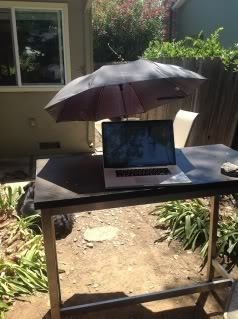
When working outdoors on a laptop, you’ll function best in the shade. The bright sun is, well, too bright. If you want to even be able to read text on a laptop in full sun, you’ll have to bump up the brightness, which will eat away at your battery life – and it won’t even be all that legible. Working outside is about reducing stress and promoting direct attention toward work-related tasks; straining with your eyes makes relaxed focus extremely hard to muster. Plus, blasting your laptop with open sun will only make it work that much harder to stay cool. If you value the length of your Macbook’s telomeres, you’ll want to stay in the shade.
Options:
You can buy a “laptop hood” that provides perpetual shade.
You can find some preexisting shade, like that from a tree.
You can bring along an umbrella. That’s what one of my Worker Bees does from home at his outdoor workstation, using a basic umbrella, a vase, and some rocks to weigh it all down. A beach umbrella stuck in the ground will also work well.
Get a laptop with a matte screen.
While glossy screens look nice in the store and indoors, they are terrible for outdoor work. Well, I suppose glossy laptop screens would work outdoors in a place like Seattle, but if there’s sun afoot? Matte, all the way.
Get an indoor/outdoor laptop.
A growing number of laptops are being made with dedicated outdoor modes. Look for models with “I/O” (indoor/outdoor), “Outdoor View,” or “Enhanced Outdoor” listed as a feature.
What if none of these options work for you? What if you can’t find a green space with reliable Internet access? Are you forever doomed to languish indoors?
No. “Working outdoors” doesn’t necessarily require total avoidance of any sign of civilization. You don’t have to climb Half Dome just to write some emails, nor must your shade be provided by a Joshua tree in the middle of Death Valley. You needn’t be remote, nor cut off from everything and everyone. You just need some fresh air.
This can take many forms, none of them extreme:
A standup workstation set up on your patio, like this commenter from last week (who is “already happier!”). Just being outside is good enough, but throw in some potted plants, a fruit tree, maybe some birds? Baby, you got yourself some green space!
Holding the next business meeting at the local public park, on a picnic table, instead of at a restaurant or in a board room at the business park.
Walking meetings, wherein you walk and talk and plan and brainstorm. Or, better yet, hiking meetings! Hey, if they were good enough for Aristotle and his students, walking meetings are good enough for the likes of you. There are numerous advantages to having walking or outdoor meetings, including:
Fewer distractions – Although I’ve seen some evidence to the contrary, most people won’t whip out their phone to check something if you’re walking and talking with them.
Greater concentration – Walking actually improves brain function, as you’re walking. Being outdoors while you do it? Even better.
What’s truly ironic – and extremely cool – about our increasing reliance on technology for essentially all aspects of work is that instead of preventing our communion with nature, they actually make it even more possible. Sure, most of us don’t get nearly enough nature access, we have to go look for it, and we like to blame work for our nature deficit, but it doesn’t have to be that way. Your boss may not be on board (yet), but unlike ever before in recent decades, we have the physical ability to take our work back to nature. No stacks of papers to be flung around by the wind, no landlines keeping us bound to our desks. The technology exists to allow us to work from almost anywhere at anytime. We live in an age of astounding possibility and potential, as of yet unrealized. If you have the freedom to make this possible, if nothing and no one is holding you back from taking your laptop outdoors, what are you waiting for? Give it a try. Refer your excuses to the lists above, and stop making them.
It doesn’t have to be every day, or even every other day. It might just mean you sneak out to the company garden for an extended break, or check your emails out in your backyard. I’m persuaded, based on the (albeit limited) research and my own experiences integrating the outdoors with my work, that adding any amount of nature exposure to your daily work life will be incredibly helpful. You may not see a massive performance boost, but you’ll be a bit less stressed. You may not be more productive, but you’ll enjoy your work more. And all that stuff matters.
Okay, that’s it for me, folks. Now it’s your turn. I want to hear what you’ve been able to accomplish. How have you melded work with nature, if at all? What roadblocks have you encountered, and how did you get around them?
Let us all know in the comment section!
Get the Free 7-Day Course on the Primal Blueprint Fundamentals for Lifelong Health Delivered to Your Inbox

June 12, 2012
How to Conduct a Personal Experiment: Biphasic Sleeping
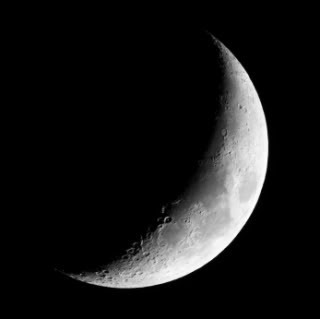 It’s time for another edition of “How to Conduct a Personal Experiment.” Last week, it was the cold water plunge. Today, we’re going to talk about running a biphasic sleep experiment. First, though, I’d like to know: how are the cold plunges going? Are they, well, cold? More importantly, did you have any difficulties setting up the experiment, identifying variables, and choosing what to measure and track? This whole personal experiment stuff is likely new to most of you, and while there’s no real “wrong” way to go about it, there will be some initial difficulties. Be sure to keep us posted in the comment section.
It’s time for another edition of “How to Conduct a Personal Experiment.” Last week, it was the cold water plunge. Today, we’re going to talk about running a biphasic sleep experiment. First, though, I’d like to know: how are the cold plunges going? Are they, well, cold? More importantly, did you have any difficulties setting up the experiment, identifying variables, and choosing what to measure and track? This whole personal experiment stuff is likely new to most of you, and while there’s no real “wrong” way to go about it, there will be some initial difficulties. Be sure to keep us posted in the comment section.
Okay, on to the new experiment.
Biphasic sleeping is exactly what it sounds like – two-phased sleep. Instead of monophasic sleeping, which is sleeping in one big unbroken block of time, biphasic sleeping is broken up into two chunks of time. I wrote about biphasic sleeping last year, explaining how considerable evidence suggests that biphasic sleeping is actually the natural sleep pattern in humans. Before the Industrial Revolution, back when darkness meant bedtime and keeping the light on after dark required the consumption of expensive candles and lamp oil, people had far more exposure to darkness. They didn’t have iPhones, laptops, big screen TVs, or even lightbulbs. They had the moon, the stars, the campfire, or maybe – if their city had implemented them – street lamps that were really just candles in glass. And this shorter photoperiod resulted in a very different way of sleeping:
You’d get to bed shortly after darkness had fallen and sleep for several hours. This was “first sleep” (later mistranslated as “beauty sleep”). Sometime around midnight, you’d wake up. You’d putter around, read a little by candlelight (if you were literate and could afford candles, that is!), make love, get up and dance, check on the animals, talk with friends or folks in your tribe, think of stately pleasure-domes in a partial waking dream state… that sort of thing. In short, you would be awake and at least moderately active. You’re not a groggy, grumpy person here, fussing with your pillows, thrashing at the comforter, and agonizing over the alarm clock. You’re reasonably alert and cheery.
Then you’d drift off to “second sleep.” Sounds cool, right, but out of the realm of possibility for us living now? Maybe not.
Studies find that modern humans living in an technological permaglow of light will revert back to the biphasic sleep pattern when exposed to shortened photoperiods (from 16 hours of light to 10 hours of light), so the potential remains.
But very few of us are humans living in contrived study settings, and that’s what could make this one a little tricky. Ideally, biphasic sleep is effortless. It just happens. You wake up, read, talk, use the loo, or do something gentle for a few minutes or a couple hours, and go back to sleep without actively trying to make it happen.
That won’t work for everyone, not without active intervention and formal experimentation. Which brings us to the personal experiment.
But why biphasic sleep?
Mostly because I find the notion that we’re all “doing it wrong” when it comes to a fundamental aspect of our lives – sleeping – extremely interesting. I mean, it’s not like it hasn’t happened to us before (diet and exercise, anyone?). It’s not out of the realm of possibility. I’d even say it’s fairly likely that we’re getting something wrong when we sleep, seeing as how 60% of Americans between the ages of 13-64 report having a sleep problem almost every night, whether it’s waking up feeling groggy or waking up too early. Even those of you who are clued in to the whole Primal thing might find it helpful to explore another way to sleep. In my last post on biphasic sleep, I referred to it as more of a thought experiment than anything else, but today I’m recommending people formally attempt to integrate it into their lives, if only for a month or so.
That said, is there more than one type of biphasic sleeping? Sure:
Natural biphasic sleep
This is what I call normal human biphasic sleep – two four-hour blocks of sleep broken up by an hour or two of wakefulness in the middle of the night. Easy to understand, if hard to implement.
Modified biphasic sleep
This is the kind of biphasic sleep that lifehackers employ. They’re not really interested in anthropological or evolutionary arguments for sleeping a particular way; they want to save time and get the minimum dosage of sleep that confers the maximum amount of benefit. They see sleep as a waste of time, albeit a necessary one. From what I can tell, lifehackers typically sleep for a 4.5 hour block of time – say, from 2 AM to 6:30, which allows them to stay up late, get three, full 90-minute sleep cycles in, and rise early to greet the day. They follow up with a 90-minute nap sometime in the late afternoon, which gives them another 90-minute cycle and enough energy to make it to the next sleep block.
Sidenote: I’m somewhat skeptical of these shortcuts when it comes to sleep. From what I can tell, they focus on REM sleep and seem to classify non-REM sleep as “wasted” sleep, as if it exists only to propel us from one REM session to the next. Eh, I’m not so sure we should be so flippant about messing with a vital physiological process, nor should we immediately discount the importance of “useless” sleep. I have no problem with hacks, usually. In fact, I usually welcome them. Just be careful when hacking something like sleep.
Okay, so how do I do it?
First, you want to determine what kind of biphasic sleep pattern is even possible for you. If you have the freedom to get to bed shortly after dark, wake up in the middle of the night for a couple hours, and go back to bed, go for natural biphasic sleep.
Choose an “absolute latest” morning wakeup time. If you have to be up by 7 AM, that’s going to determine how late you can go to bed.
Determine a bedtime. It should be at least nine hours from bedtime to morning wakeup time, giving you two four hour sleep blocks and one hour of free time in between. If you’re up by 7 AM, you should be in bed by 10 PM. If you want another hour in the middle of the night to do stuff, go to bed by 9 PM.
Reduce exposure to artificial light once the sun goes down, or at least two hours before your scheduled bed time, just like it would have been for most of human history. Turn off the TV, install f.lux on your computer, light some candles, and/or wear blue light-blocking glasses or goggles. It probably won’t work as well otherwise.
If you use lighting during your mid-phase waking period, be sure to wear blue light-blocking goggles or stick to a natural light, like candle or yellow light. Try not to bust out the PS3 for some online gaming.
If you need more alert waking time in a day and would like to try reducing the amount of sleep you require, try modified biphasic sleep.
Choose a 4.5 hour block of time. This will be your “anchor” block of sleep, and most people have success placing this at night or during early morning. Try 10 PM-2:30 AM, perhaps, or 2:00 AM-6:30 AM. Set an alarm, at least until you become entrained to that schedule.
Wake up and go about your day. Get some light exposure, preferably daylight if applicable.
Take a 90 minute nap, to begin 8-10 hours after your wake up time. If you woke up at 6:30 AM, you might nap from 4:30 PM-6 PM.
Set a realistic goal:
“I want to improve my sleep.”
“I want to feel just as refreshed on less sleep.”
Come up with a hypothesis, like:
“Modified biphasic sleep will reduce my sleep requirements while maintaining my wakefulness, productivity, workout recovery, and immune function.”
“Natural biphasic sleep will reduce my nighttime anxiety about waking up and ruining my sleep, thereby improving my sleep.”
Now, we identify some of the variables and think about how they might affect the outcome:
Length of sleep blocks – Are four hours enough during natural biphasic sleep? Do you prefer two three hour blocks instead of a 4.5 hour block and a 90 minute nap?
Timing of sleep blocks – Do you need less time in between the anchor block and the nap? How do you sleep with one hour between your two sleep phases? How about two hours?
Alarm – Does the alarm help or hinder your biphasic sleep?
Light – How does light exposure affect the effectiveness of your biphasic sleep? Is total abstention before bedtime necessary?
Activity while awake – What are you using your free awake time to do? Does reading by candlelight have a different effect on sleep quality when compared to going for a walk?
Next, let’s take some measurements. What to measure?
Productivity - Is your work suffering or improving? How many productive hours are you getting?
General wakefulness – How are your energy levels throughout the day? Are you getting a mid afternoon slump? Use a simple 1-10 scale.
Grogginess – Do you feel well-rested upon waking? After which phase do you feel the most rested? 1-10 scale.
Recovery – How are your workouts? Are your numbers improving or falling?
Immune system – Are you getting sick more often?
Try the biphasic sleep for at least a week, preferably closer to four weeks. Then once you’ve established a baseline and have some data to work with, refer to the list of variables above, make a change to a single variable, and give it another try for some duration to see if biphasic sleep is for you.
This isn’t for everyone. As Robb Wolf points out, when you have 14 hours of uninterrupted darkness and potential sleep time, you have the luxury of being a little more picky with your sleep patterns. When you don’t have emails to answer or an unprecedented renaissance of quality television to tear into, you’re going to get sleepy when darkness falls, go to bed pretty early, wake up after several hours, do your thing, and go back to sleep for another several hours. Biphasic sleep is probably natural. But we’re not living in very natural times. Or, if we are, natural means something different from what it once did. That’s the whole premise of the Primal Blueprint, after all – identifying what our ancient genes expect from the environment and figuring out how to modify our modern environment to fit those genes.
Let me know what you think in the comment board, and be sure to check out today’s contest.
Grab a copy of Primal Blueprint Quick & Easy Meals for over 100 Primal Recipes You Can Prepare in 30 Minutes or Less

Contest: An Experiment of One
In keeping with the recent “How to Conduct a Personal Experiment” theme, I’ve put together a fun contest. I’ve been sharing my ideas for personal Primal experiments. Now it’s your turn. Tell me your personal experiment ideas for a chance to win a Primal prize package. All the details are below. But first, the prize…
The Prize
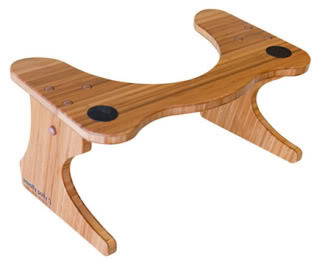 You think Grok took a seat on a porcelain thrown when nature called? Of course not! Grok squatted, and so should you. But what are we to do? Is it time for all-out bathroom renovations? No, there’s a simpler solution, and that’s where Squatty Potty comes to the rescue. The winner of this drawing gets their pick of the Squatty Plastic, Squatty Classic or the Squatty Tao Bamboo. Learn more about the benefits of squatting here and order your own Squatty Potty today.
You think Grok took a seat on a porcelain thrown when nature called? Of course not! Grok squatted, and so should you. But what are we to do? Is it time for all-out bathroom renovations? No, there’s a simpler solution, and that’s where Squatty Potty comes to the rescue. The winner of this drawing gets their pick of the Squatty Plastic, Squatty Classic or the Squatty Tao Bamboo. Learn more about the benefits of squatting here and order your own Squatty Potty today.
 As the Square36 website says, “Do you ever wish you had a bit more space to fully extend and maximize your workout without feeling confined? Now you can with Square36, the world’s 1st oversized workout mat.” That about sums it up. This exercise mat is 6′ x 6′ and is 6 mm thick – thicker than most yoga/workout mats. With the Square36 mat you can easily convert your living room into a workout studio. Just unroll it and you’re set. It’s also great for couples yoga or as a play mat for children. It retails for $99.99, but you can get one for free if you are the lucky winner of this contest.
As the Square36 website says, “Do you ever wish you had a bit more space to fully extend and maximize your workout without feeling confined? Now you can with Square36, the world’s 1st oversized workout mat.” That about sums it up. This exercise mat is 6′ x 6′ and is 6 mm thick – thicker than most yoga/workout mats. With the Square36 mat you can easily convert your living room into a workout studio. Just unroll it and you’re set. It’s also great for couples yoga or as a play mat for children. It retails for $99.99, but you can get one for free if you are the lucky winner of this contest.
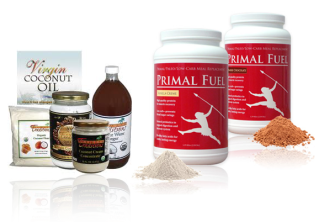
A $100 gift certificate to Tropical Traditions. If you missed out on the contest I held a couple weeks ago, this is a second chance to stock up on Organic Virgin Coconut Oil, or some Grass-Fed Lamb, Beef or Bison. Or, if that doesn’t float your boat, you could pick up some massage oils, or something for your dog. The list goes on and on, and you’ll have your pick if you win this contest.
As if that wasn’t enough, the winner will also receive one canister of either Dark Chocolate or Vanilla Creme Primal Fuel.
That’s over $300 worth of Primal goodies, and all you have to do for a chance to win is…
The Contest
I want you to come up with your own personal experiments. Do it like so:
Goal: Lose body fat.
Hypothesis: Taking a walk in a fasted state every morning will lower my body fat.
Experiment: I will walk for 30 minutes upon waking and prior to eating breakfast.
Measurements to Take: Each week I will both measure my waist and rank my subjective “clothes fit better” assessment on a scale of 1-10.
Duration of Experiment: Four weeks.
Variables to Test: After four weeks I will conduct additional experiments testing the effect of walking for different periods of time, of walking at different speeds, and of fasting for shorter or longer periods of time before my first meal of the day.
or
Goal: To feel less stressed out in life.
Hypothesis: Daily deep breathing exercises can reduce stress and provide a sense of calm and relaxation.
Experiment: In a quiet place I will perform 5 deep breathing cycles (4 seconds to inhale, 7 to hold, and 8 to exhale) 3 times every day.
Measurements to Take: I will rank and record my stress levels on a scale of 1-10 both immediately before and after each session, and 1 hour following each session.
Duration of Experiment: Two weeks.
Variables to Test: After two weeks I will conduct additional experiments to see if more or fewer deep breathing cycles each session, and more of fewer sessions each day provide better or worse results.
Keep it brief, don’t take my examples, give maybe a line or two for each of the six sections, and email me your experiment ideas. Your ideas can be in any area that interests you and you think might be of interest to us. Each experiment up to ten counts as one entry in today’s contest. Ten experiments means ten opportunities to win. Use the email subject heading “Experiment of One” when submitting your answers, so I can easily find and organize all submissions.
The Deadline:
June 14, midnight, PDT. Only two days!
Who is Eligible:
Anyone with an idea for a personal experiment.
How a Winner is Chosen:
A random drawing will be held among all entrants.
Fine Print:
I will likely be compiling select submissions into a digital book that will be made available later this month. Stay tuned for details.
By emailing me your advice you are agreeing to let me use it in this digital book.
To ensure anonymity, your name will not be published.
Thanks to everyone in advance for participating. Grok on!
Grab a copy of Primal Blueprint Quick & Easy Meals for over 100 Primal Recipes You Can Prepare in 30 Minutes or Less

June 11, 2012
Dear Mark: Preservatives in Lard, Ace-K, Raspberry Gorging, and Veal
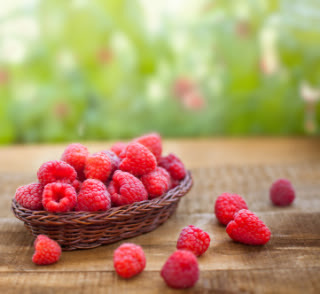 What would you do if someone gifted you with a 5-pound tub of lard? Jump for joy? Grab a spoon? All reasonable responses, but what if that tub of lard had a label that said “contains BHA and BHT”, two antioxidants commonly used to preserve processed food, cosmetics, and pharmaceuticals – how would you react? That’s the first question I tackle in today’s edition of Dear Mark. After, I discuss whether or not acesulfame potassium, an artificial sweetener, is safe to consume, whether Joe should venture into the creepy raspberry forest threatening to overtake his house, and how organic dairies handle their male calves.
What would you do if someone gifted you with a 5-pound tub of lard? Jump for joy? Grab a spoon? All reasonable responses, but what if that tub of lard had a label that said “contains BHA and BHT”, two antioxidants commonly used to preserve processed food, cosmetics, and pharmaceuticals – how would you react? That’s the first question I tackle in today’s edition of Dear Mark. After, I discuss whether or not acesulfame potassium, an artificial sweetener, is safe to consume, whether Joe should venture into the creepy raspberry forest threatening to overtake his house, and how organic dairies handle their male calves.
Ready? Let’s get to it:
Mark,
I was recently given a huge tub of lard that says it contains BHA and BHT. I read on your site that they are antioxidants but their safety isn’t very proven.
I would throw it away but it’s like 5 pounds and I HATE wasting stuff! Is this lard hydrogenated? Is it safe to use up, or would I really be better off throwing it away and finding better quality lard?
thanks!
- adam
The good news is that this lard probably isn’t hydrogenated. If it were, it would say so. Does the label indicate the presence of trans-fats? If not, you’re in the clear.
As for the BHA and BHT, there is some controversy:
Natural News says they’re linked to allergies, hyperactivity, rashes, and other health issues. This compendium of BHA and BHT-related studies, which the Natural News article used as a reference, also paints an alarming picture. And a quick stroll through Pubmed finds that as recently as 2011, researchers were using BHT as a proven “tumor promoter.”
But both BHA and BHT, which are also known as synthetic phenolics, have also shown chemopreventive effects against certain cancers. Just like radiation exposure can promote hormesis - the right dose can upregulate protective mechanisms, thus having a net positive health effect – it seems likely that the right dose of BHA and BHT could be beneficial, at least in certain disease states (like aflatoxin exposure, for example). Of course, we don’t know what that dose looks like, and all the other phenolics (natural food-based ones, not synthetics) we’re getting are probably good enough. I’m not suggesting we seek out BHT and BHA; I’m just trying to give them a fair shake.
In my opinion, however, the carcinogenicity controversy doesn’t really matter. The mere presence of BHA and BHT indicates that this lard was made to have a longer than usual shelf-life. That worries me. I mean, I imagine it’s technically safe, and it probably won’t be rancid/oxidized because of the BHT and BHA, but it’s almost certainly not quality lard from quality pastured pigs. This is industrial lard, from pigs fed vegetable oil and junk, and the omega-6 content is likely sky high. Whenever I buy lard from a local farmer, it’s in a glass jar or some kind of makeshift tub. There are no labels and I can rest assured that it contains some level of favorable nutrition, like vitamin D (from the pigs getting sunlight) and a higher saturated:polyunsaturated fat ratio (from the pigs eating forage and leftover vegetables from the farm, rather than corn and soy-based junk). And there is definitely no BHA or BHT.
My husband & I drink an energy drink sweetened with Ace-K. Is this ok to drink? Thanks.
Becky
Ace-K, or acesulfame potassium, is one of the only non-caloric sweeteners to show evidence of provoking an insulin response:
One study using live rats found that direct transfusions of acesulfame potassium increased insulin secretion. Later, the same researchers performed an in vitro study, this time subjecting isolated rat pancreatic islets to acesulfame K solutions. After eliminating other variables, they found that the artificial sweetener had an independent effect on insulin secretion. Note, however, that the first study used direct transfusions, rather than oral dosing, and the second study was in vitro using isolated clusters of pancreatic cells. These aren’t necessarily real world conditions, but the results are somewhat worrying. Slightly more disturbing were the results of a recent study, which found that mother rats who consumed acesulfame potassium during pregnancy gave birth to offspring with altered sweet receptors. Just a single oral infusion of Ace-K showed up in the mom’s amniotic fluid and breast milk.
I’d avoid it, if I were you. Doesn’t delicious, delicious coffee work for you?
Hey Mark,
There’s a raspberry wood near my home with literally millions of delicious raspberries coming into season soon.
I’m wondering whether I should show any restraint; Obviously a great source of vitamin C and anti-oxidants but are there any detrimental things if consumed in huge quantities?
Many Thanks,
Joe
Joe, I’m jealous. You have millions of wild, free, delicious raspberries growing in a “raspberry wood.” Heck, I didn’t even know a “raspberry wood” was even a real thing before your email. I’m imagining a forest full of raspberry bushes that tower over you, festooned with berries the size of apples. Man. Is that what’s going on in your neighborhood?
Joe, you lucky dog, you.
But seriously, go for it. Raspberries are the perfect blend of sweet and tangy, and actually quite low in sugar. They’re loaded with soluble fiber, excellent food for your gut flora to ferment into short chain fatty acids. They have vitamin C, as you mention, but also manganese and an antioxidant called ellagic acid. Enjoy them. Eat what you can, and freeze or dry what you can’t. If you don’t, most of them will go to waste and become shriveled up things that put George Costanza after a cold swim to shame.
Dear Mark,
I’ve googled your blog, but have not seen this issue addressed:
What happens to male calves born to an organic grass-fed dairy cow? Or a regular dairy-cow? Do they get killed right after birth as in this story from England? What do you think of this alternative: British veal poised for an “ethical” comeback?
I haven’t eaten veal in ages, but I think this “rose-veal” could be a great Primal food.
Thanks for your time and effort. I’m fairly new to Paleo/Primal (2 months) and I read your blog for hours every day to catch up.
No need to answer directly; but I’d love to know more about your views on this matter if it made it into one of your posts.
Thanks again for everything you do!
Gaby
What happens to male calves in an organic, grass-fed dairy? It depends on the dairy. Organic Pastures, a California-based raw milk dairy that sells at my local farmer’s market, castrates its male calves, puts them out to pasture, and lets them grow up to become beef steers. Their beef is fairly good, especially for being from a dairy, rather than a dedicated meat cow farm. According to this post, male calves borne to major organic dairy brands Organic Valley and Horizon follow similar paths, eventually becoming organic beef cows. I’d imagine not all organic dairies do this, but probably most. Of course, you could contact the dairy in question and ask them yourself. That’s the surest way.
Rose veal looks great to me. I’m not a huge veal fan, partly for the taste and partly for the fact that most veal is raised intensively, but I’d try some rose veal.
Even if you have no ethical qualms about eating it, intensively-raised veal lacks certain nutritional qualities. For one, CAFO-calves are kept indoors, typically in stalls that allow very little (if any) movement. While this lets you cut the resultant meat with a fork, it also takes away the rich flavor that comes with muscles that actually, you know, move the animal around. Conventional veal calves are also fed an unnatural diet of milk-replacement formula. If it’s anything like human baby formula, the nutritional profile (plus all the intangibles we have yet to even identify) of calf formula pales in comparison to actual cow milk. Natural diets (like grass for cows and pasture for chickens) tend to result in better tasting, more nutritious food. I doubt veal is somehow unique in this respect.
Thanks for the questions, and let me know what you think in the comment board!
Grab a Copy of The Primal Blueprint 21-Day Total Body Transformation and Start Getting Primal Today!

June 10, 2012
Weekend Link Love
 If you can, please support the Kickstarter campaign for “In Defense of Fat,” a new documentary examining how ancestral health could help counteract the “bad science eating at America’s health.” They’ve got a ways to go, but with your help, I think we can get this very important project off the ground!
If you can, please support the Kickstarter campaign for “In Defense of Fat,” a new documentary examining how ancestral health could help counteract the “bad science eating at America’s health.” They’ve got a ways to go, but with your help, I think we can get this very important project off the ground!
Timothy, the Urban Primalist, shares his reflections on a year of lifting heavy things, plus the latest lecture from Shovelglove 201.
This kid took a stand. Will you?
The truck driver’s face: visceral photographic evidence of what a lifetime of UVA exposure (without UVB to balance it out) could do to your skin.
Melissa and Dallas Hartwig, those crazy smart folks responsible for the Whole9, are birthing their first book in a few days. Go grab a copy of It Starts with Food. It’s really, really good.
Anyone who’s ever been a caregiver for a loved one knows the difficulty of keeping on top of everything: doctor visits, medication histories, treatments, procedures, and all the rest. With The Medical Day Planner, the proactive caregiver or patient can stay abreast of that stuff so it doesn’t consume every waking moment, leaving them free to focus on actually living.
Northern Californians, if you’re looking for like-minded folks who will join you in asking the waiter questions like “what did the cows eat?” and “what kind of oil do you use to make your aioli?”, waste no time and join the Northern California Primal Meetup Group. Everyone else, find or start one in your area.
A stick figure grapples with the question every wearer of Vibram Fivefingers has had to tackle.
Recipe Corner
Instead of trying to cobble together a passable meal at a fast food joint, why not go to Grok Donald’s?
For those of you into the whole post-workout big meal thing, I can’t think of a better option than sweet potato, apple, sausage, and egg hash.
Time Capsule
One year ago (June 10 – June 16)
10 Foods I Couldn’t Live Without – From cowboy ribeyes to salmon skin to blackberries, these are the ten foods I couldn’t live without (well, I could, but wouldn’t want to).
Are Cell Phones Bad For Male Fertility? – Is keeping a cell phone in your pocket adjacent to your vitals going to be a problem?
Comment of the Week
Ok, Mark. Now, not only do I have to convince my boss to let me have a stand-up work station but now I have to ask for my stand-up work station to be outside? Wish me luck, everyone!
- Don’t forget to convince your boss to let you traipse around barefoot and do pullups on the office door frames!
Grab a Copy of The Primal Blueprint 21-Day Total Body Transformation and Start Getting Primal Today!

June 9, 2012
Grilled Eggs with Mexican Chorizo
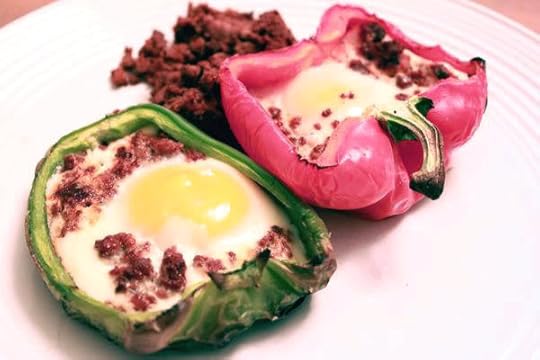 Grilling isn’t typically an early morning activity, but Grilled Eggs with Mexican Chorizo might change that. Of course, just because eggs are involved you don’t have to serve this tasty meal for breakfast. It’s also great as a side or main dish for dinner.
Grilling isn’t typically an early morning activity, but Grilled Eggs with Mexican Chorizo might change that. Of course, just because eggs are involved you don’t have to serve this tasty meal for breakfast. It’s also great as a side or main dish for dinner.
The method for grilling eggs is simple but ingenious: crack a raw egg into a bell pepper half and then grill until set. Cradled in the pepper, the egg cooks perfectly and the pepper is roasted by the flames, taking on a smoky, charred flavor. Fantastic as-is, you can bump the flavor up another notch by adding Mexican chorizo, a type of pork sausage that’s intensely seasoned with dried chiles, herbs and spices.
Unlike Spanish chorizo, which is cured and more similar to salami, Mexican chorizo is raw and needs to be cooked before eating. It’s sometimes sold in links, but often cooked as loose ground meat. If you’ve tasted Mexican chorizo before, you know how addictive the earthy, smoky, spicy flavor is. The flavor is so rich and complex that you might be surprised by how easy chorizo is to make at home.
Most of the seasonings you need are probably already in your spice rack: chile powder, paprika, dried oregano, cumin and cinnamon. The last, and most important, seasoning is dried chiles (either ancho or guajillo are most common) that have been re-hydrated and blended into a thick paste. Many grocery stores sell dried chiles and you can also buy them at Hispanic markets or from online spice stores.
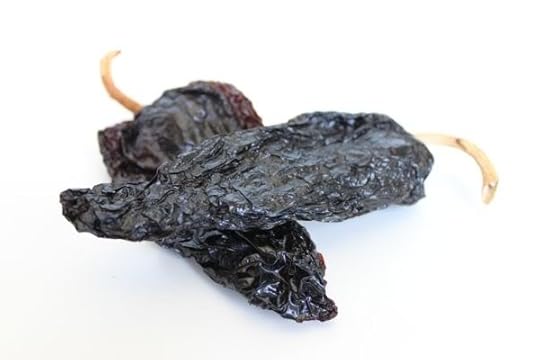
The exact blend of spices in Mexican chorizo varies widely, depending on who’s making it. This recipe has a really nice balance of flavor; it’s neither too smoky or spicy. You can add another dried chile or some cayenne pepper to make it hotter; throw in allspice or cloves for a gentler, sweeter flavor.

Mexican chorizo tastes especially good with eggs, but can also be sautéed with dark leafy greens or tossed cold into a salad. You might even find yourself plucking pieces directly out of the skillet – it’s that good. In this recipe, though, the grilled eggs really steal the spotlight. The soft, creamy texture of the egg is amazing with the roasted pepper. Serve grilled eggs with a cup of coffee for breakfast or eat grilled eggs for dinner, either way you’re gonna love ‘em.
Makes 4 Grilled Eggs
Ingredients:
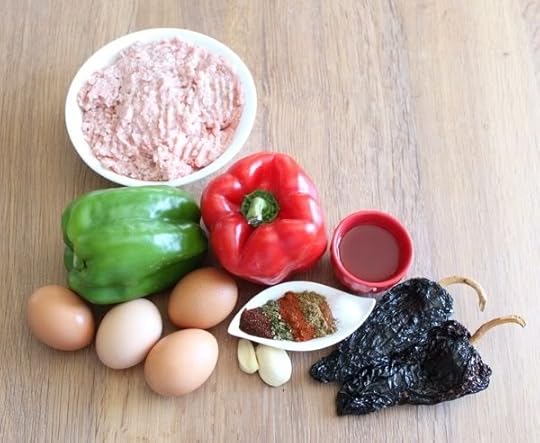
2 dried chiles, either ancho or guajillo
1/4 cup apple cider vinegar
1 pound of ground pork
1 teaspoon chile powder
1 teaspoon paprika
1 teaspoon dried oregano
1/2 teaspoon ground cumin
1/8 teaspoon ground cinnamon
1/2 teaspoon salt
2 garlic cloves, finely chopped
2 large bell peppers
4 eggs
Instructions:
Use a pairing knife or kitchen shears to cut the stem off the dried chiles, cut the chiles open and scrape out the seeds. (If you want spicier sausage, keep some of the seeds in the pepper.)
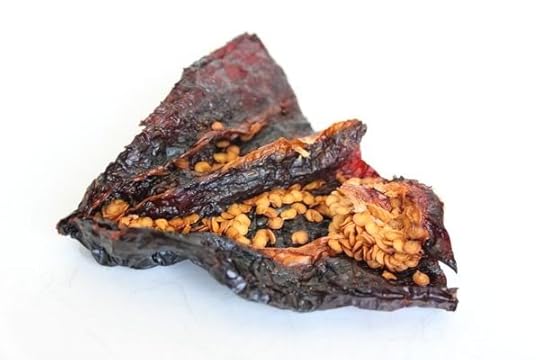
In a dry skillet or pot heated on high, toast the chiles on each side for about 25 seconds so they start to blister and puff up a bit. Add a few cups of water; leave the heat on until the water begins to boil and then turn off the heat, cover the pot, and let chiles soak until soft, about 30 minutes.
Drain the water and combine the chiles and vinegar in a blender. Blend until a smooth paste forms.

In a large bowl, use your hands to mix the chile paste with the ground pork and the next 7 ingredients until well combined.
Cook the chorizo in a skillet over medium heat, breaking up the meat into small pieces as it cooks. It should be cooked through and slightly browned on the outside, which will take about 8-10 minutes.
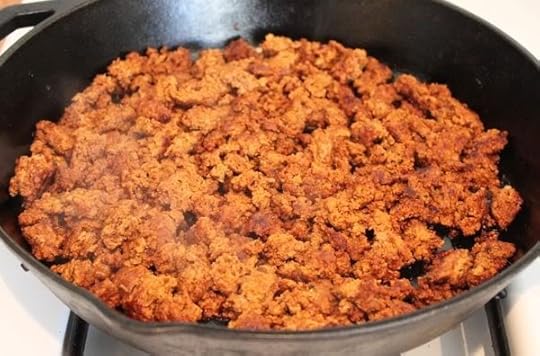
Heat the grill to high.
Cut the bell peppers in half through the stem. Scrape out the seeds and cut out the white membrane.

Crack an egg into each half of bell pepper. Sprinkle a handful of the chorizo inside the pepper.
Place the filled peppers over the hottest part of the grill – charring the skin gives it a nice smoky flavor.
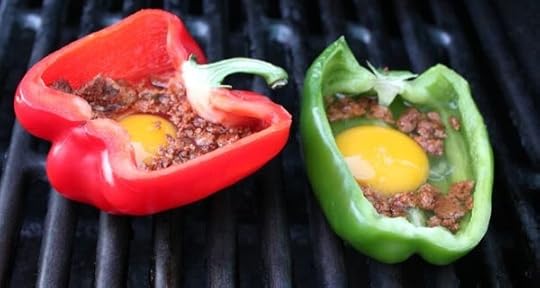
Close the grill, checking on the egg’s progress once or twice as it cooks. Grille for 8-10 minutes for a soft yolk. Sprinkle with sea salt and enjoy.

Grab a copy of Primal Blueprint Quick & Easy Meals for over 100 Primal Recipes You Can Prepare in 30 Minutes or Less

June 8, 2012
I Am a Better Man in Every Sense of the Word
It’s Friday, everyone! And that means another Primal Blueprint Real Life Story from a Mark’s Daily Apple reader. If you have your own success story and would like to share it with me and the Mark’s Daily Apple community please contact me here. I’ll continue to publish these each Friday as long as they keep coming in. Thank you for reading!
 Mark,
Mark,
I have to start by saying thank you for providing me with the tools that allowed me to change my life.
I live in New England and as a former “New Englander” you know very well that we enjoy our food, especially in the winter months. I grew up eating what my parents fed me which was mostly comprised of the typical standard American diet foods. Luckily, I was very active throughout my childhood and into my teens, playing sports year round, so I was able to stay in relatively good shape without worrying what I stuffed into my pie hole. Needless to say, after school was finished I started gaining weight. Same ol’ song and dance, the sports stopped and the pounds rushed on.
I became a firefighter/paramedic which if there is anyone involved with public safety you’ll know that the meals cooked at the station are so incredibly carb heavy that it’s difficult to get up for the bell even hours after the traditional “face stuffing”. Anyway, from my late teens until a few months ago I tried and tried to “eat healthy” and go to the gym as often as I could. Inevitably, “eating healthy” left me starving, and getting married and having my first child allowed almost NO time for the gym… I needed a change.
I did as much research as I could on living a healthy lifestyle. Due to the MASS confusion of healthy living I sort of ran around in circles for quite a while. It started by reading magazines like Men’s Health and Men’s Fitness, etc. What I found was that these magazines promoted quick and “easy” ways to sick pack abs and huge arms. The magazines were primarily focused on exercise, particularly easy exercise. I followed the so-called easy way to six pack abs and huge arms, lo and behold… beer gut and weak arms.

I knew at this point I needed a fundamental change. I hadn’t ever felt a dire need for immediate change until I began getting injured at work. With all the lifting and carrying of sick patients I do on a weekly basis I began to feel nagging back pain, weakness, fatigue, and then finally a back spasm that put me out of work for two weeks and made me a frequent flyer at my chiropractor. Right around this time I landed my dream career profession – a full-time career firefighter. I couldn’t have been happier. I started the fire academy in late May of 2011, trained hard and met some great friends that I’ll have for the rest of my life. In particular I became close with a guy named Mike. Mike is an avid CrossFitter who in my opinion was the fittest guy I had ever met. He was strong as hell(!) and agile, which confused me due to his size and strength. In essence, I was incredibly jealous. I believed I was in great shape, but it was at the cost of being sore and stiff all the time.
One day about 2 months after we had finished the fire academy, Mike and I happened to land on the same engine company for the shift. I finally built up the courage to ask for some advice, which was difficult because I thought I had it all figured out and was just in a short remission from being fit. Anyway, I shared my dilemma with Mike and asked, what the heck do you do beside CrossFit? He said one word to me that literally changed my life: PALEO. At first I thought it was ridiculous, there was no way I could give up pasta, bread and whole wheat products, they’re healthy… or so I thought. I finally gave myself a slap upside the head and said to myself, “If Mike is this successful, there must be something to this Paleo thing.” I began my research. Being a fiend for knowledge, I couldn’t stop reading. The first book I purchased was your book, The Primal Blueprint. After reading it, everything made so much sense to me that I couldn’t believe that this wasn’t common knowledge. Following The Primal Blueprint I read Robb Wolf’s The Paleo Solution. Needless to say, I immediately began putting my knowledge into practice and the results just began reinforcing everything that I had learned.
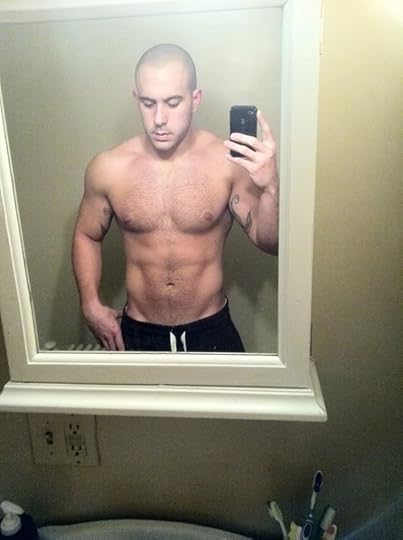
After about 6 months I went from 225 lbs to 198 lbs, and from about 17-18% body fat to approximately 8-9% body fat. My nagging back injuries disappeared. My fatigue completely disappeared. I had my first child as previously stated, my son Jack, and now I’m a dad that’s full of energy as well as a husband who is never too tired and fatigued for our true primal instincts! *wink wink* My main point here is that this change of lifestyle has made me a better husband, a better father, a better firefighter/paramedic and in general, a better man in every sense of the word, and I cannot thank you enough for being a 50-something year old man who can still drive a 27 year old man to be as strong/agile and sharp as you are. This June I’m headed back up to Maine to hike Mt. Katahdin for the second time, and I’m gonna give it hell this time around! Grok on!!!
Grab a Copy of The Primal Blueprint 21-Day Total Body Transformation and Start Getting Primal Today!

Mark Sisson's Blog
- Mark Sisson's profile
- 199 followers



